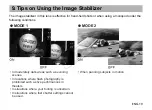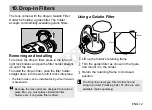
ENG-2
a
Safety Precautions
a
Safety Precautions
•
Do not look at the sun or a bright light source through the
lens or camera.
Doing so could result in loss of vision. Looking
at the sun directly through the lens is especially hazardous.
•
Do not point the lens or camera at the sun or photograph
it.
This is because the lens concentrates the sun’s rays even
when the sun is outside the image area or when shooting
with backlight, which could cause malfunction or fire.
•
Whether it is attached to the camera or not, do not
leave the lens under the sun without the lens cap
attached.
This is to prevent the lens from concentrating
the sun’s rays, which could cause a fire.
•
Do not stand on the lens case.
Falling off the case
could result in injury.
•
Do not stack lens cases.
A falling lens case could
cause an injury.
Handling Cautions
•
If the lens is taken from a cold environment into a
warm one, condensation may develop on the lens
surface and internal parts.
To prevent condensation in
this case, first put the lens into an airtight plastic bag before
taking it from a cold to warm environment. Then take out
the lens after it has warmed gradually. Do the same when
taking the lens from a warm environment into a cold one.
• Do not leave the lens in excessive heat such as in a
car in direct sunlight.
High temperatures can cause
the lens to malfunction.
This device complies with Part 15 of the FCC Rules. Operation is
subject to the following two conditions: (1) This device may not
cause harmful interference, and (2) this device must accept any
interference received, including interference that may cause
undesired operation.
Do not make any changes or modifications to the equipment
unless otherwise specified in the instructions. If such changes or
modifications should be made, you could be required to stop
operation of the equipment.
This equipment has been tested and found to comply with the
limits for a class B digital device, pursuant to part 15 of the FCC
Rules. These limits are designed to provide reasonable protection
against harmful interference in a residential installation. This
equipment generates, uses and can radiate radio frequency
energy and, if not installed and used in accordance with the
instructions, may cause harmful interference to radio
communications.
However, there is no guarantee that interference will not occur in
a particular installation. If this equipment does cause harmful
interference to radio or television reception, which can be
determined by turning the equipment off and on, the user is
encouraged to try to correct the interference by one or more of
the following measures:
• Reorient or relocate the receiving antenna.
• Increase the separation between the equipment and receiver.
• Consult the dealer or an experienced radio/TV technician for
help.
This Class B digital apparatus complies with Canadian ICES-003.
COP
Y
Содержание 2746B002
Страница 1: ...EF800mm f 5 6L IS USM Instruction ENG COPY ...
Страница 17: ... CANON INC 2008 CT1 8556 003 0812Ni COPY ...



































